T: 03 5174 9071
40 Year Anniversary of Gippsland Crematorium
Written by Jenifer Whitwam (Trust member)
The development of the Traralgon Cemetery Crematorium was a long and challenging process that spanned several decades. The idea of establishing a crematorium was first discussed in the early 1950s. In 1952, the Hazelwood Trust expressed support for the crematorium and offered to help with the submission. However, responses from undertakers in 1955 concluded that there was no need for a crematorium at that time. In 1959, the President and Secretary visited the Ballarat Crematorium, but there were no funds available to pursue the project further. The idea was shelved in 1960.
In 1963, there was a renewed interest in the crematorium, and by 1973, the Church of England Synod was writing to the government requesting the establishment of a crematorium in Gippsland on social grounds.
In 1974, the Trust asked the Traralgon Shire Council to contact Gippsland Municipalities to support a crematorium attached to the Traralgon Cemetery. Despite some discouragement from the Health Department, the Trust continued to pursue the project. In 1975, a quotation for a furnace for the crematorium was submitted. The Trust also sought funds from the Latrobe Valley Development Committee.
By 1976, the Church of England Synod organised to hold a public meeting in the Little Theatre, Traralgon. 70 to 80 attended from Lang Lang to Bairnsdale and “The Gippsland Crematorium Investigation Committee” was set up to formulate a submission to the government. This was supported by the Funeral Directors and the clergy from throughout Gippsland. They had been spending much valuable time escorting and attending cremations at Springvale. They were finding that this was very time-consuming and they had been gathering evidence of the increased traffic conditions which involved time and costs to the families as well. Even back in 1934, Funeral Director, Dave McCubbin, was offering to arrange funerals out of the area but by this time conditions had changed which did not make it easier. The committee presented evidence of other crematoriums which were run as effective businesses in other states and contended that a crematorium in Gippsland would lead to a swing towards cremations. The Government needed convincing as they felt 2000 cremations a year would be needed to be viable. The Committee was arguing that a budget of $200,000 made up of $100,000 from the Government and $100,000 of private loan would be sufficient and supported that with monetary figures which showed they did not need the numbers the government was saying.
In 1977 the Trust publicly announced their support for the crematorium and prepared a submission for public approval by the State Government and affirmed that they would make land available for the crematorium. The land being made available was where the current crematorium stands and at that time was the southern boundary of the cemetery. A meeting was held on August 30, 1977, with the Department of Public Health, and it was agreed that 10 acres was sufficient for the crematorium.
In 1978, the Department of Health requested assurance that the Trust could arrange finance for the crematorium. However, in 1979, several banks notified that they could not loan money to finance the crematorium. The Trust continued to seek funds and support from various sources. In 1980, the City of Traralgon accepted the principle of arranging a grant of $100,000 for the crematorium.
By 1981, the Department of Health recommended to the Treasurer that the government fund the requested $100,000 for the crematorium. The National Bank offered a loan of $120,000 provided there was government security. With this there was a private loan of $100,000. The Trust engaged Keith Wilson Engineer Group to prepare preliminary plans for the crematorium.
In 1982, the Trust selected K Walter of Leith Bartlett and Partners as the architect for the crematorium and the builder was J J B Constructions of Morwell. The construction of the crematorium faced several challenges, including cost reductions and design alterations. By 1984, the Trust had received working plans for the crematorium. The crematorium was named “Gippsland Crematorium, Traralgon”. Chairs were purchased for the chapel with enough seating for 30 people. The Trust continued to seek funds and support for the project. The crematorium was finally opened to the public in December 1984.
In 1985, the crematorium began operations, and by the end of the year, it had conducted 52 cremations. The Trust continued to address issues related to the crematorium’s operation and sought to promote its services throughout Gippsland. The development of the Traralgon Cemetery Crematorium was a testament to the dedication and perseverance of the Trust members in providing a valuable service to the community.
The first cremation was held on the 16 January 1985 and in the first year an average of three cremations were held each week. The crematorium was officially opened on 21 March 1985 by the Minister of Transport, Mr Tom Roper who was the former Health Minister.
At the time the Trust members were J K Chenhall, Chairman, Miss M I Nixon, J F Alcorn, J D Black, A G Lindsay, P A Murray, A E M Nielsen and R L Patrick. The Secretary was D Dunbar JP.
Finances were still difficult and it wasn’t until February 1987, that the builder and the Tabo cremator manufacturer received their final payment.
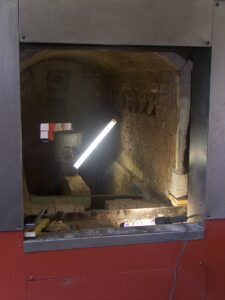
Inside the cremator during construction.
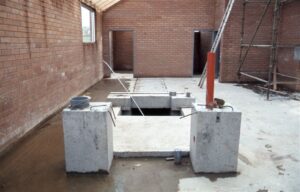
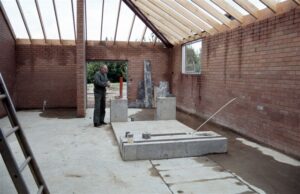
Building the first crematorium in 1984
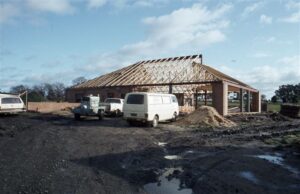
It took some time for a cremation to become more widely used and publicity was sought throughout Gippsland as was support of the funeral directors. At that time, it appeared that country people preferred burial as opposed to cremation. Access to the cemetery was still via Tyers Road up until 1996. By then the chapel and crematorium were being more used. Tenders were called for, to extend the secretary’s office and clergy change rooms which was carried out by Rick Doultree.
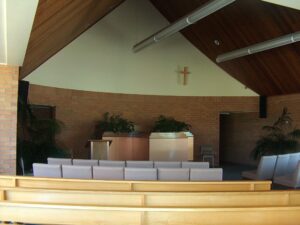
Inside the chapel when first built.
However, by 1998 an extension of the chapel was needed. A coolroom was fitted into the crematorium by 1999. Local shop fitters were asked about moving the windows out to enlarge the area. Seating in the chapel was improved and heating/air conditioning was installed. L V Shopfitters did the windows and Refair the air conditioning.
Because of the increase in usage, two new Major Cremators were purchased in 2013 and there was considerable expansion of the building to accommodate the cremators, storage, seating capacity, office requirements and the build of a 120 person function centre.
This was followed by a refurbishment of the Chapel in 2018 to increase the capacity and functionality of an asset that had seen such growth in usage. At this time the ambience of the chapel was completely changed as was the seating, the sound system and the overall functionality. The reception and office area was also altered, yet again, to match the increased usage within the cemetery.
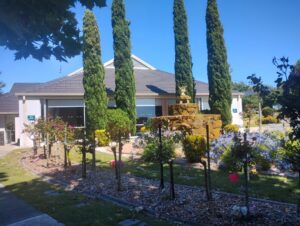
The current chapel and fountain.
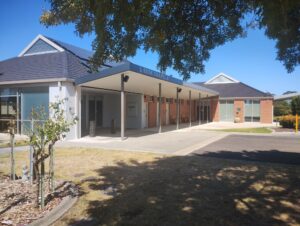
The Rose Chapel & Oak Function Room
From the beginning the number of cremations has slowly increased which is shown by the statistics for the last 10 years. The use of The Rose Chapel for services both burial and cremations, is also increasing as is the use of the function centre – The Oak Room.